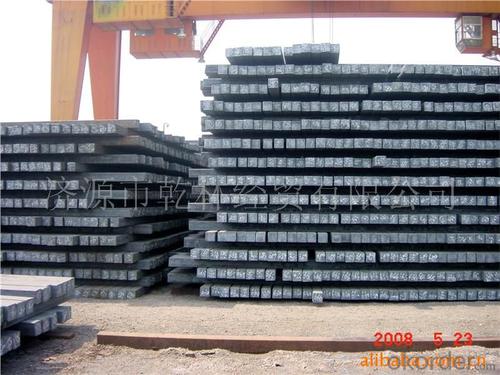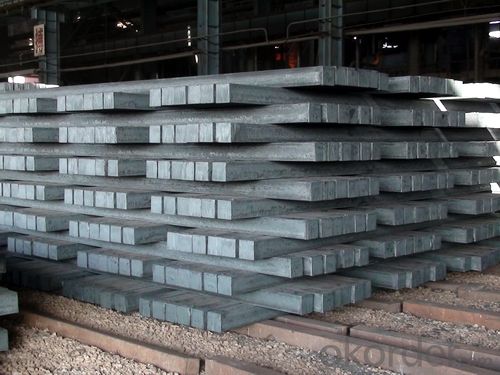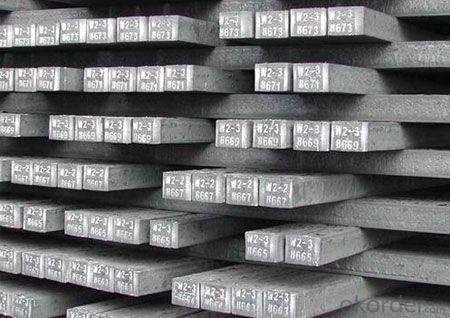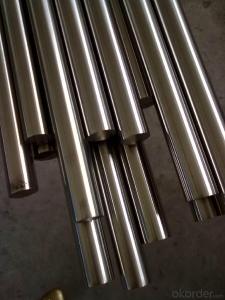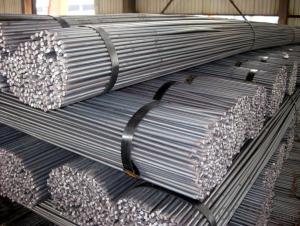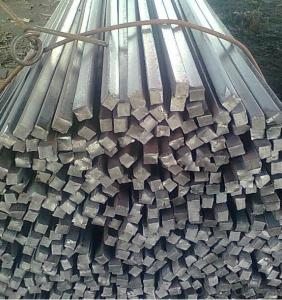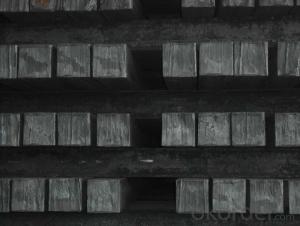Steel Square Bar Hot Rolled 5MM-28MM High Quality Hot Rolled
- Loading Port:
- Tianjin
- Payment Terms:
- TT or LC
- Min Order Qty:
- 25 m.t.
- Supply Capability:
- 20000 m.t./month
OKorder Service Pledge
OKorder Financial Service
You Might Also Like
Product Description:
OKorder is offering Steel Square Bar Hot Rolled 5MM-28MM High Quality Hot Rolledat great prices with worldwide shipping. Our supplier is a world-class manufacturer of steel, with our products utilized the world over. OKorder annually supplies products to European, North American and Asian markets. We provide quotations within 24 hours of receiving an inquiry and guarantee competitive prices.
Product Applications:
1) Suitable for making various strong cutting tool abrasion resistance, impact resistance.
2) Used to produce all kinds of high hard and super hard saw blade, drill, tap, broach, gear hob and various kinds of milling cutter.
3) Used for advanced punching die, screw die, and the toughness and complicated shape of the punch, etc.
4) Is used for cold forging die and drawing mode, etc.
5) Recommended watchcase factory, screw factory and other cold stamping products industry use.
Product Advantages:
OKorder's Steel Square Bar Hot Rolled 5MM-28MM High Quality Hot Rolledare durable, strong, and resist corrosion.
Main Product Features:
· Premium quality
· Prompt delivery & seaworthy packing (30 days after receiving deposit)
· Corrosion resistance
· Can be recycled and reused
· Mill test certification
· Professional Service
· Competitive pricing
Product Specifications:
Standard: GB,
-Grade: Q195 or equivalent.
-Chemical Composition:
Standard | Grade | Element (%) | ||||
GB | Q195 | C | Mn | S | P | Si |
0.06~0.12 | 0.25~0.50 | ≤0.050 | ≤0.045 | ≤0.30 | ||
Measures of HR Square Bar (small measures):
(Section of HR Square Bar)
-Length of a side and Theoretical weight of Square Bar.
Length of a side(mm) | Theoretical weight(kg/m) | Length of a side(mm) | Theoretical weight(kg/m) |
7 | 0.385 | 22 | 3.80 |
8 | 0.502 | 24 | 4.52 |
9 | 0.636 | 25 | 4.91 |
10 | 0.785 | 26 | 5.30 |
11 | 0.950 | 28 | 6.15 |
12 | 1.13 | 30 | 7.06 |
13 | 1.33 | 32 | 8.04 |
14 | 1.54 | 34 | 9.07 |
15 | 1.77 | 36 | 10.17 |
16 | 2.01 | 38 | 11.24 |
17 | 2.27 | 40 | 12.56 |
18 | 2.54 | 42 | 13.85 |
19 | 2.82 | 45 | 15.90 |
20 | 3.14 | 48 | 18.09 |
21 | 3.46 | 50 | 19.63 |
Notes:
1, The theoretical weights in the list, base on the density of 7.85 g/cm3.
2, Formula for theoretical weight of Square bar: (length of a side)2 * 0.00785
3, The numbers with *mean that they are not regular or we don’t offer them.
-Regular length of Square Bar:
Steel | Length of a side (mm) | Length of steel (m) |
Normal steel | < 25 | 4~10 |
> 25 | 3~9 | |
Steel of high quality | All measure | 2~6 |
Tool steel >75 | 1~6 |
FAQ:
Q1: Why buy Materials & Equipment from OKorder.com?
A1: All products offered byOKorder.com are carefully selected from China's most reliable manufacturing enterprises. Through its ISO certifications, OKorder.com adheres to the highest standards and a commitment to supply chain safety and customer satisfaction.
Q2: How do you package the angle steel when shipping?
A2: All goods are packed in bundles with steel strips and shipped by container or break bulk.
Q3: The products are invoicing on theoritical weight or on actual weight?
A3: We can do it in both manners, according to the customers' request.
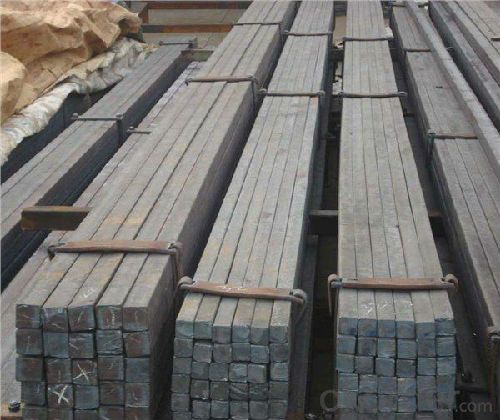
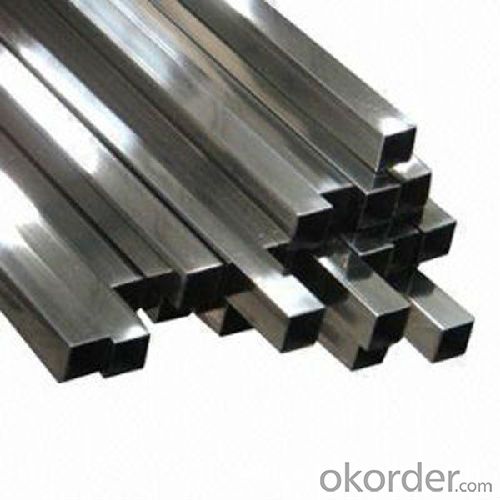
- Q: What are the different surface treatment methods used for steel billets?
- There are various surface treatment methods used for steel billets to enhance their properties and improve their performance. Some of the commonly used methods include: 1. Pickling: This method involves immersing the steel billets in an acid bath, typically hydrochloric or sulfuric acid, to remove any scale or oxides from the surface. Pickling helps in improving the surface finish and prepares the billets for further processing. 2. Shot blasting: In shot blasting, steel billets are subjected to high-velocity steel shots to remove any rust, scale, or contaminants from the surface. This method not only cleans the surface but also improves its roughness, promoting better adhesion of coatings or paints. 3. Phosphating: Phosphating is a chemical process that involves the application of a phosphate coating on the steel billet's surface. This coating provides corrosion resistance and improves paint adhesion. Phosphating is commonly used as a pre-treatment method before applying organic coatings. 4. Galvanizing: Galvanizing is a popular surface treatment method that involves coating the steel billets with a layer of zinc. This process provides excellent corrosion resistance and protects the steel from environmental factors. Galvanized steel billets are commonly used in outdoor applications or in industries where rust prevention is crucial. 5. Electroplating: Electroplating is a process where a thin layer of metal, such as chromium or nickel, is deposited onto the steel billet's surface using an electric current. This method improves the aesthetic appearance, corrosion resistance, and wear resistance of the steel billets. 6. Coating: Coating refers to applying a protective layer on the steel billet's surface using paints, varnishes, or other protective coatings. These coatings act as a barrier against corrosion, abrasion, and other forms of damage. Coatings can be applied through various methods like spraying, dipping, or powder coating. 7. Passivation: Passivation is a chemical process used to remove free iron and other contaminants from the steel billet's surface. This process helps in restoring the steel's passive film, which provides corrosion resistance. Passivation is commonly used in stainless steel billets to enhance their resistance to rust and corrosion. These surface treatment methods play a vital role in improving the quality, durability, and performance of steel billets, making them suitable for a wide range of applications in industries such as construction, automotive, and manufacturing.
- Q: What is the purpose of using steel billets in the manufacturing industry?
- The purpose of using steel billets in the manufacturing industry is primarily to serve as a raw material for further processing and shaping into various steel products. Steel billets are semi-finished metal products that are cast in a specific shape and size, typically in a square or rectangular cross-section. These billets provide a consistent and standardized starting point for the production of a wide range of steel products, such as bars, rods, wire, tubes, pipes, and structural components. By using steel billets, manufacturers can ensure uniformity in the material properties and dimensions of their end products, which is crucial for maintaining quality and meeting industry standards. Moreover, steel billets offer several advantages in terms of their strength, durability, and versatility. Steel is known for its exceptional strength-to-weight ratio, making it an ideal choice for applications that require high structural integrity and load-bearing capacity. The use of steel billets allows manufacturers to produce components that can withstand heavy loads, extreme temperatures, and harsh environmental conditions. Furthermore, steel billets can be easily shaped and processed through various techniques such as rolling, forging, extrusion, and machining. This flexibility enables manufacturers to create a wide range of steel products with different shapes, sizes, and properties, catering to diverse industrial needs. Overall, the purpose of using steel billets in the manufacturing industry is to provide a reliable and versatile raw material for producing high-quality steel products that serve various applications in construction, automotive, aerospace, machinery, infrastructure, and many other sectors.
- Q: What are the common surface defects in steel billets during cooling?
- Common surface defects in steel billets during cooling include cracks, surface scaling or oxidation, and surface decarburization.
- Q: Which is good for pure iron billet?
- If you would like to consult more detailed information, I suggest you choose Shanghai far west special steel products Co., ltd..
- Q: What are the main differences between hot-rolled and cold-rolled steel billets?
- Hot-rolled and cold-rolled steel billets differ primarily in their manufacturing processes and resulting steel characteristics. To produce hot-rolled steel billets, the steel is heated above its recrystallization temperature, typically around 1200°C (2200°F), and then rolled into the desired shape or size. This involves the use of large-scale machinery, such as rolling mills, which apply significant pressure to shape the steel. Consequently, hot-rolled steel billets have a rough and scaled surface. On the contrary, cold-rolled steel billets are created by further processing the hot-rolled steel. The hot-rolled steel is cooled to room temperature and then passed through a series of rollers at lower temperatures, usually below 1000°C (1832°F). This process offers more precise control over the dimensions and surface finish of the steel. As a result, cold-rolled steel billets exhibit a smoother and more polished appearance compared to their hot-rolled counterparts. Regarding physical and mechanical properties, hot-rolled steel billets generally possess higher yield strength but lower ductility compared to cold-rolled steel. This is due to the hot-rolling process causing strain hardening in the steel, resulting in increased strength but reduced ability to deform without breaking. In contrast, cold-rolled steel retains more ductility as a result of the controlled rolling process at lower temperatures. Another significant distinction lies in the dimensional accuracy of the two steel billet types. Hot-rolled steel billets are known to have larger dimensional tolerances, meaning there can be variations in their thickness, width, and length. Conversely, cold-rolled steel billets possess tighter dimensional tolerances, leading to more precise and consistent dimensions. In summary, the primary differences between hot-rolled and cold-rolled steel billets stem from the manufacturing process, surface finish, physical and mechanical properties, and dimensional accuracy. Understanding these disparities is crucial when selecting the appropriate type of steel billets for specific applications, as each type offers its own advantages and disadvantages.
- Q: What are the market trends and growth prospects for steel billets?
- Steel billets play a vital role in the steel industry as they serve as the primary material for various downstream applications. The growth and market trends of steel billets are greatly influenced by factors like global economic growth, infrastructure development, and the demand for steel in different sectors. One notable market trend for steel billets is the increasing demand from the construction industry. With the rapid urbanization and infrastructure development in emerging economies, there is a rising need for steel-intensive construction projects. Steel billets are extensively used in the construction of bridges, buildings, and other infrastructure projects, which drives the demand for this product. Another market trend is the growing demand for steel billets in the automotive industry. The automotive sector is a major consumer of steel, and as the industry shifts towards lightweight and high-strength materials, the demand for steel billets is expected to increase. Steel billets are used in the production of various automotive components, including engine parts, chassis, and suspension systems. Furthermore, the increasing focus on renewable energy sources such as wind and solar power is expected to drive the demand for steel billets. Steel components are required for wind turbines and solar panel structures, and as renewable energy projects expand globally, the demand for steel billets is likely to experience significant growth. In terms of growth prospects, the steel billets market is expected to witness steady growth in the coming years. The Asia-Pacific region, particularly China and India, is projected to dominate the market due to their robust construction and infrastructure sectors. These countries have extensive urbanization projects and ongoing infrastructure development plans, which will contribute to the demand for steel billets. Additionally, the recovery of the global economy after the COVID-19 pandemic is expected to boost the demand for steel billets. As economies bounce back and industrial activities regain momentum, the demand for steel in various sectors, including construction, automotive, and energy, will increase, positively impacting the steel billets market. However, it is important to note that market trends and growth prospects for steel billets can be influenced by factors like fluctuations in raw material prices, trade policies, and environmental regulations. Furthermore, the increasing adoption of alternative materials such as aluminum and composites in certain applications may pose a challenge to the growth of the steel billets market. In conclusion, the market trends for steel billets are driven by the demand from the construction, automotive, and renewable energy sectors. The growth prospects for this market are promising, particularly in the Asia-Pacific region as economies recover from the pandemic and infrastructure projects gain momentum. Nevertheless, challenges such as fluctuations in raw material prices and competition from alternative materials should also be taken into consideration.
- Q: What is the role of steel billets in the manufacturing of conveyor belts?
- The manufacturing process of conveyor belts heavily relies on steel billets, which are essential in creating the various components of the belt. These billets, derived from molten steel, serve as the initial stage in production. To begin, the steel billets undergo heating and rolling processes to form thin sheets or strips, depending on the desired thickness of the conveyor belt. These sheets are then further processed to construct the core structure of the belt, providing the necessary strength and durability to withstand demanding conditions. Moreover, steel billets play a crucial role in producing the metal reinforcements within the belt. These reinforcements, typically in the form of steel cords or wires, are embedded into the belt to enhance its tensile strength, preventing stretching or breaking under heavy loads and ensuring longevity and reliability. Additionally, steel billets are utilized in manufacturing the pulley system of the belt. Pulleys are essential components that facilitate the movement of materials along the belt. Made from solid steel billets, these pulleys are machined and designed to smoothly guide the belt while maintaining proper tension. In conclusion, steel billets serve as the foundation for creating the core structure, reinforcements, and pulleys of conveyor belts. Their strength and versatility make them an ideal material for producing belts that can withstand the rigorous conditions of industrial applications, guaranteeing efficient and reliable material handling processes.
- Q: What are the different types of steel billet casting processes?
- There are several different types of steel billet casting processes, each with its own advantages and disadvantages. Some of the most commonly used processes include continuous casting, ingot casting, and direct chill casting. Continuous casting is a widely used method that involves pouring molten steel into a water-cooled mold, which then solidifies into a continuous strand or billet. This process offers high production rates, improved quality control, and reduced energy consumption compared to other methods. Continuous casting is ideal for producing large volumes of steel billets with consistent dimensions. Ingot casting, on the other hand, is an older and less commonly used method. It involves pouring molten steel into individual molds called ingot molds, which solidify into solid blocks or ingots. Once solidified, the ingots are then reheated and shaped into billets through processes like rolling or forging. Ingot casting allows for greater flexibility in terms of alloy composition and size, but it typically requires more energy and has a slower production rate compared to continuous casting. Direct chill casting is another popular process, especially for producing aluminum alloys. It involves pouring molten steel into a water-cooled mold, similar to continuous casting. The main difference is that direct chill casting uses a rotating mold to create a cylindrical, or sometimes rectangular, billet. This process offers better control over the solidification process, resulting in improved microstructure and mechanical properties of the billet. Other less common steel billet casting processes include electromagnetic casting, where an electromagnetic field is used to control the flow of molten steel, and centrifugal casting, which involves pouring molten steel into a rotating mold to create cylindrical billets. These methods are typically used for specialized applications and are not as widely adopted as continuous casting or ingot casting. In conclusion, the different types of steel billet casting processes include continuous casting, ingot casting, direct chill casting, electromagnetic casting, and centrifugal casting. Each method offers unique advantages and is suitable for different production requirements and steel grades. The choice of casting process depends on factors such as desired billet size, production volume, alloy composition, and cost considerations.
- Q: Can steel billets be used in the production of sculptures and artwork?
- Yes, steel billets can be used in the production of sculptures and artwork. Steel's strength and durability make it a popular choice for creating large outdoor sculptures or intricate metal artwork. The material can be shaped, welded, and manipulated to bring artistic visions to life, offering artists a versatile medium to express their creativity.
- Q: What are the common surface defects found in steel billets?
- Common surface defects found in steel billets include: 1. Scale: Scale is a type of oxide layer that forms on the surface of steel due to exposure to high temperatures during the manufacturing process. It appears as a flaky, rough layer and can affect the quality of the steel. 2. Surface cracks: Cracks can form on the surface of steel billets due to various reasons such as improper cooling, improper handling, or excessive stress during the manufacturing process. These cracks can weaken the steel and reduce its structural integrity. 3. Inclusions: Inclusions are non-metallic impurities that can be present in the steel billet. These impurities can be in the form of oxides, sulfides, or other foreign materials. Inclusions can cause weak spots in the steel, leading to potential failures or defects in the final product. 4. Decarburization: Decarburization is the loss of carbon content from the surface of the steel billet. It occurs when the steel is exposed to high temperatures for an extended period or inadequate protective atmospheres during the manufacturing process. Decarburization can reduce the hardness and strength of the steel. 5. Surface roughness: Steel billets may have surface irregularities or roughness due to improper processing or handling. This can affect the surface finish and overall appearance of the billet. 6. Roll marks: Roll marks are impressions or patterns left on the surface of the steel billet during the rolling process. These marks can be caused by issues with the rolling mill equipment, such as improper alignment or worn-out rolls. 7. Lamination: Lamination refers to the presence of layers or separations within the steel billet. This defect can occur due to improper solidification during the casting process, inadequate temperature control, or the presence of impurities. It is important to detect and address these surface defects in steel billets to ensure the production of high-quality steel products. Various inspection techniques, such as visual inspection, ultrasonic testing, magnetic particle testing, and eddy current testing, can be used to identify and classify these defects.
Send your message to us
Steel Square Bar Hot Rolled 5MM-28MM High Quality Hot Rolled
- Loading Port:
- Tianjin
- Payment Terms:
- TT or LC
- Min Order Qty:
- 25 m.t.
- Supply Capability:
- 20000 m.t./month
OKorder Service Pledge
OKorder Financial Service
Similar products
Hot products
Hot Searches
Related keywords



